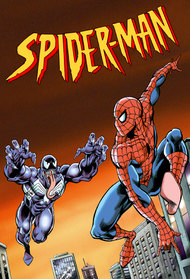

#SPIDER MAN 1994 ANIMATED SERIES SERIES#
The series has found a respectable level of mainstream success, and will likely break Spider-Man '94's record for the most episodes fora Spidey during the course of its third season.
#SPIDER MAN 1994 ANIMATED SERIES TV#
It had the misfortune of replacing the much beloved Spectacular Spider-Man, after Sony transferred the Spider-Man TV rights back to Marvel. The show even featured narration by Stan Lee, though that material tends to be omitted in syndication nowadays.Ĥ Ultimate Spider-Man Lifespan: 52 episodes (2012-present) Ultimate Spider-Man may well be the wallcrawler's most controversial animated project to date. Spider-Man and His Amazing Friends also boasted some pretty impressive vocal talent, including soon-to-be Transformers mainstays Dan Gilvezan and Frank Welker as Spider-Man and Iceman, respectively. While campy at times, the show managed to counter that quality with some solid dramatic material at times, taking great pains to explore the origins of Peter Parker, Bobby Drake, Anjelica Jones, and other characters at different points. It was one of the first Marvel TV projects to really take advantage of the shared universe.

While occasionally they would team up to battle traditional Spider-Man rogues like Chameleon or Electro, more often the heroes would cross over with other Marvel mainstays like the Avengers and X-Men. The show cast the three heroes as college students and roommates. Firestar was initially created as a stand-in for Human Torch, whose TV rights were tangled up elsewhere at the time (hence why he was also replaced by H.E.R.B.I.E. The latter character is easily the show's most lasting contribution to the Marvel Universe. Suddenly, the eternally unlucky Spidey was joined by two other superhero partners - Iceman and Firestar. "Catches thieves just like flies!"ĥ Spider-Man and His Amazing Friends Lifespan: 24 episodes (1981-83) Where one 1981 Spider-Man animated series offered a traditional take on Spider-Man's world, this show - despite sharing a lot of the same character designs, including for Peter Parker - took a much different approach. And the theme song of course has stood the test of time. Any hardcore Spider-Man fans owe it to themselves to check out a few episodes, if only for curiosity's sake. The '67 series isn't great, but it has a certain goofy charm. The budget was so slim that at one point, Bakshi even reused elements from another of his animated projects, Rocket Robin Hood.

Unfortunately, the budget was slashed even further, necessitating the removal of Spidey's villains. As you might expect based on Bakshi's resume, the latter two seasons took on a distinctly darker and more psychedelic tone. After Grantray-Lawrence went bankrupt, the show was passed onto Krantz Films, with legendary animator Ralph Bakshi taking control. To further save time, the animators only drew the webbing on Spidey's gloves and mask. Though the production values were higher than those of The Marvel Super Heroes (wherein the episodes basically consisted of crudely animated comic book panels), Spider-Man still featured rudimentary animation and often reused stock footage. Many of Spidey's iconic villains and supporting characters of the day put in appearances. The first season was produced by Grantray-Lawrence Animation, resulting in a show pretty faithful to the early Stan Lee/Steve Ditko Amazing Spider-Man comics.

The show is also interesting in how fundamentally it changed between the first and second seasons. Aside from that iconic tune, the show is best remembered today for its lovably clunky animation and as fodder for many an Internet meme. 7 Spider-Man (1967) Lifespan: 52 episodes (1967-1970) The original Spider-Man animated series will always have a special place in the hearts of Spidey fanatics, if only because of its ridiculously catchy theme song.


 0 kommentar(er)
0 kommentar(er)
